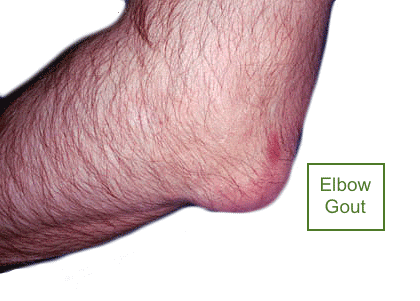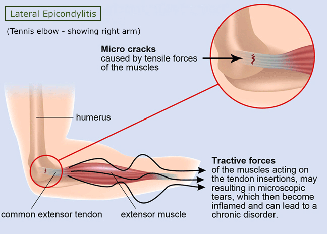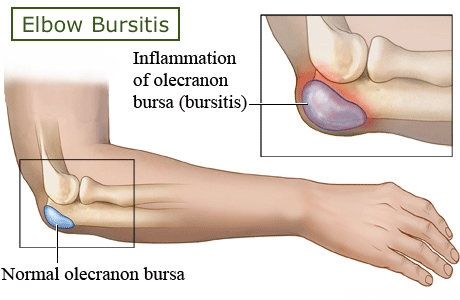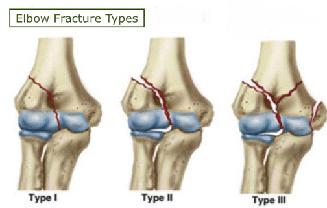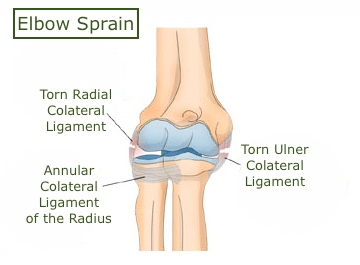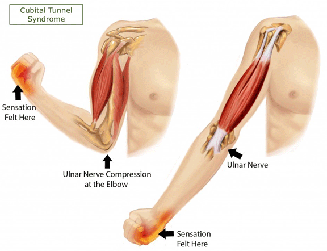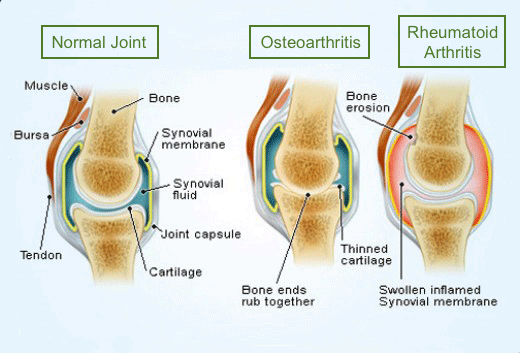Elbow Pain, Lateral Epicondylitis (Tennis Elbow), Medial Epicondylitis (Golf Elbow)
What is it?
Elbow pain refers to any type of pain or discomfort that arises in or around the elbow. Elbow pain can be the result of an injury or of a medical condition. Treatment options are dependent on the cause of elbow pain, which has to be determined before any specific treatment can be recommended.
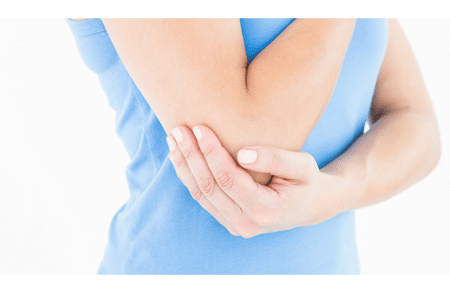
Common Causes of Elbow Pain
Epicondylitis of the Elbow
Epicondylitis of the elbow can be either Lateral Epicondylitis (tennis elbow or Medial Epicondylitis (golf elbow). These conditions can be acute, when there is inflammation and swelling due to an injury (tendonitis) or can be chronic, when muscles and tendons that are in poor health are overused resulting in continual pain (tendinopathy).
Lateral Epicondylitis
Lateral Epicondylitis or tennis elbow is a painful condition of the elbow caused by overuse of the tendons that join the forearm muscles to the lateral epicondyle, the outside bony portion of the elbow. It is caused by overuse of the extensor tendons of the forearm, especially trying to stabilize the wrist when the elbow is straight. Tennis elbow is not just an ailment of tennis players. Painters, plumbers, and carpenters are particularly prone to developing tennis elbow. Studies have shown that auto workers, cooks, and even butchers get tennis elbow more often than the rest of the population. Common symptoms of tennis elbow are: Pain or burning on the outer part of the elbow and weak grip strength.
Medial Epicondylitis
Medial epicondylitis or Golfer’s elbow is a painful condition felt at the medial epicondyle, a bony bump on the inside of the elbow, where the muscles that flex your wrist and fingers attach. Golfer’s elbow is caused when more wrist flexion force is applied than the muscles and tendons can handle. Golfer’s elbow occurs not only in golfers, but also is those who practice trades where gripping is involved. It can occur at any age, however, sufferers are generally between the ages of 35 and 50. Males and females are affected equally. Common symptoms are: tenderness directly over the bony medial epicondyle, and often points of tenderness in the wrist flexor muscles.
Treatment of Epicondylitis
Conservative treatment options for acute epicondylitis include rest, ice, or immobilization of the elbow. Commonly used medications includes non-steroidal anti-inflammatory drugs (NSAIDs), such as ibuprofen, naproxen, and diclofenac. Physical therapy using specific exercises to strengthen and stretch the muscles of the forearm is important to treat the tendinopathy. When tendonitis pain is severe and not improving with conservative measures , ultrasound guided corticosteroid injections to the covering tissue (sheath) of the tendon can be helpful. In chronic tendinopathy, dry needling of the tendon can help restart the healing process. Ultrasound or extracorporeal shock-wave therapy have also shown to be effective to treat tendonpathy. Platelet rich plasma (PRP) injections is an excellent treatment of tendinopathies. PRP can be very helpful in accelerating the healing process when previous treatment options have not proved effective.
Bursitis
Bursitis is the inflammation of a bursa, a normal fluid filled sac which decreases rubbing, friction between bones and muscles/ tendons. Elbow (or olecranon) bursitis can occur due to injury, arthritis, infection, or minor trauma, even leaning on the elbow (student’s elbow). Elbow bursitis leads to swelling like a ball under the skin at the tip of the elbow (“popeye’s elbow”), appearing like a ball under the skin, which may be painful and cause tenderness around the elbow. Bursitis can be treated through rest, ice, compression of the area, and elevation of the elbow (RICE). Pharmacological approaches include NSAIDs, such as ibuprofen and naproxen, or local corticosteroid injection to the affected area. Fluid aspiration may also be effective in decreasing pain followed by a corticosteroid injection. Ultrasound guidance is an important tool to aid in proper needle placement in the bursa.
Bone Fractures
Bone fractures, a break in a bone in or around the elbow joint is a common cause of elbow pain. Bone fractures can happen as a consequence of an impact or other traumatic injury. The severity of bone fractures is variable and will determine the type of treatment needed. Immobilization with cast is generally required, but fracture stabilization with orthopedic pinning or open joint surgery may be necessary.
Elbow Sprains
Elbow sprains occur when ligaments get overstretched or tear. One or more ligaments can be injured during a sprain. Sprains can occur due to a sudden hyperextension of the elbow, for example. Pain will depend on the severity of the injury – whether there is a partial or complete tear, and whether one or more ligaments are involved. Treatment usually involves rest, ice, compression and immobilization of the elbow. NSAIDs are the most common pharmacological approach.
Ulnar Nerve Entrapment (Cubital Tunnel Syndrome)
Ulnar nerve entrapment (Cubital Tunnel Syndrome) occurs when there is pinching of this nerve, which travels between the tip of the elbow and the inner elbow bone. This entrapment can occur due to direct injury to the nerve and pressure from surrounding tissues. Ulnar nerve entrapment can cause tenderness in the elbow and usually leads to pain in the inside (5th finger side) of the forearm,. Numbness and tingling may be felt on the palm and on the little and ring fingers. Treatment usually involves rest, avoiding pressure to the elbow, and immobilization with splints. Pharmacological options often include NDAIDs, such as aspirin or ibuprofen. Physical therapy to strengthen the ligaments and tendons in the hands and elbows may be effective. In severe cases, surgical intervention may be needed to remove the source of compression to the nerve or to reposition the nerve so that it is no longer compressed.
Arthritis
Arthritis is a painful joint disorder. Its causes can be inflammatory, degenerative, infectious or metabolic in nature. Besides pain, the most common symptoms include swelling, warmth, tenderness, stiffness and decreased range of motion. The treatment of arthritic pain will depend on the type of arthritis.
Osteoarthritis
Osteoarthritis (degenerative arthritis) is a chronic disease characterized by the breakdown of cartilage in the joints, leading to a loss of cushioning at the ends of the bones, and causing the bones to rub against each other. Elbow OA is often the result of overuse or injury. Inflammation may be present at early stages of osteoarthritis, but as it progresses, it is mainly characterized by the degenerative changes in joint tissues. Besides pain, this often leads to loss of movement in the joint. Treatments for pain associated with osteoarthritis often include NSAIDs, but their efficacy is limited. Anticonvulsant and antidepressant drugs have been shown to be effective in the treatment of pain associated with osteoarthritis.
Rheumatoid Arthritis
Rheumatoid arthritis (inflammatory arthritis) is a chronic inflammatory disease of the joints that occurs when the immune system starts to attack its own tissues (autoimmune), in this case the membrane lining the joints (synovial membrane).The ankles are affected in the vast majority of people with rheumatoid arthritis. It generally occurs in a symmetrical pattern, which means that if one ankle is affected, the other will most likely also be affected. Besides the common symptoms of arthritis, specific symptoms of rheumatoid arthritis may include fatigue, occasional fevers, and loss of energy. Treatment for pain associated with rheumatoid arthritis is mostly based on the use of corticosteroids, NSAIDs, and disease modifying anti–rheumatic drugs.
Gout
Gout (metabolic arthritis) is a form of arthritis that occurs when excess uric acid deposits in the form of crystals in the joints. It may develop following an illness or an injury, or be caused by stressful events, alcohol or drugs. It is usually first noticed due to swelling and intense pain in the big toe, getting better after a few days even without treatment. Similar symptoms may be later felt on and off in other joints, including the elbows. Treatments for acute attacks of gout include NSAIDs, corticosteroids, and colchicine, which works best within the first 12 hours of an acute attack. When attacks are recurrent, NSAIDs or colchicine in small daily doses may be prescribed as a preventive measure, as well as drugs that lower the blood levels of uric acid.
